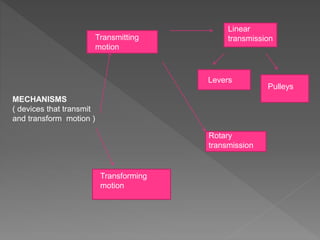00.mechanisms
- 2. INDEX 1. INTRODUCTION 2. MECHANISM 3. DEFINITION 4. CLASSES 5. MATHEMATICAL PROBLEMS 6. ANIMATION
- 3. INTRUDUCTION
- 4. MECHANISM Thanks to the mechanism of this simple tool, we can move heavy objects using a small force and a fulcrum. This is composed of a rigid bar that can rotate freely around a point of support called fulcrum. This mechanism works if thereâs one part doing resistence and the other making the effort.
- 5. DEFINITION The lever is a simple machine whose function is to transmit force and vary displacement. It can be used to amplify the mechanical force that is applied to an object, to increase its speed or distance traveled, in response to the application of a force.
- 6. CLASSES
- 7. MATHEMATICAL PROBLEM ï LAW OF THE LEVER ï Formula:
- 8. Paula Lombas Zapatero Ainhoa RodrÃguez ObregÃģn
- 9. MECHANISMS ( devices that transmit and transform motion ) Transmitting motion Transforming motion Linear transmission Rotary transmission Levers Pulleys
- 10. A pulley is simply a collection of one or more wheels over which you loop a rope to make it easier to lift things. PULLEYS COMPOUND MOVABLE FIXED
- 11. A fixed pulley is a simple machine that uses a wheel with a groove. The other end of the rope attaches to a load, or the object youâre needing to move. F = L
- 12. A flag pole is an example of fixed pulley A water well is another example of fixed pulley
- 13. A movable pulley is a pulley that is free to move up and down, and is attached to a ceiling or other object by two lengths of the same rope. F = L/2
- 14. An elevator is an example of movable pulley A crane is an example of movable pulley
- 15. A compound pulley is a combination of a fixed and movable pulley. F = L / 2 n
- 16. You use de compound pulley in the saliboats You use de compound pulley to elevate the bike
- 20. A pulley is a wheel on an axle that is designed to support movement and change of direction of a cable or belt, or transfer of power between the shaft and cable or belt. ...
- 21. A pulley attached to many pulleys
- 22. N= rpm D= diameter N1 x D1 = N2 x D2 N1/N2 = D2/D1
- 26. Transmitting Linear Rotary pulleys gears gear Worm gear Gear with chain Gear train
- 27. Mechanism of worm gear A worm gear is a gear consisting of a shaft with a spiral thread that engages with and drives a toothed wheel âĒ How it works? An electric motor or engine applies rotational power via to the worm. The worm rotates against the wheel, and the screw face pushes on the teeth of the wheel. The wheel is pushed against the load.
- 28. Gear train âĒ Gear train is a combination of gears, is used for transmitting motion and power from one shaft to another shaft. Gear trains are used to achieve large and different velocity ratio in small area or space.
- 29. Types of gear train âĒ Simple gear train âĒ Compound gear train âĒ Reverted gear train âĒ Epicyclical gear train
- 30. Gears with chains âĒ A gear through which motion is transmitted by a chain that runs in a groove or engages the cogs of a sprocket wheel
- 31. N1 X Z1 = N2 X Z2 N= rotary velocity (rpm) Z= nš of cogs N1/N2=Z2/Z1 INVERSE RELATION (size/velocity)
- 32. Leire SÃĄnchez Manuel RodrÃguez 3š A Technology L
- 33. A mechanism is a system of parts working together in a machine. -Other types of mechanism -Rotary into linear -Function M
- 34. ï WeÂīre going to be talking about three mechanisms that transform rotary movement into linear movement. These three mechanisms are: -Rack and pinion -Winch -Nut and bolt L
- 35. ï Rack and pinion THIS USES A SMALL COGWHEEL OR GEAR MOUNTED ON A TOOTHED BELT OR BAR. Ex.: locking door M
- 36. ï Winch THIS CONSITS OF A CRANK HANDLE ATTACHED TO THE AXLE OF A CYLINDRICAL DRUM. Ex: lifting weights on industrial processes. L
- 37. ï Nut and bolt THIS CONSITS OF A BOLT OR THREADED BAR AND A NUT THAT HAS THE SAME INTERIOR DIAMETER AS THE DIAMETER OF THE BOLT. Ex.: holding railways M
- 38. ROTARY INTO RECIPROCATING Paula Prieto Delgado AidÃĐ Ãlvarez FernÃĄndez
- 39. WHAT WE ARE GOING TO EXPLAIN
- 40. CRANK-LINK-SLIDER EXAMPLE: In a crank-link-slider the slider moves from one side to another and the connecting road that is joined to the crank off center makes it rotate
- 41. CRANKSHAFT EXAMPLE: Is a serie of holes connected to slides, so when the mechanism rotates, it makes the slides move forwards and backwards
- 42. CAM EXAMPLE: Is an egg-shaped disc with an slide and a follower. The disc makes the slide go up when itâs largest part touches it.
- 43. ECCENTRIC The disc with centre of rotation positioned off centre rotates and the flat follower rises and falls constantly. EXAMPLE:










































